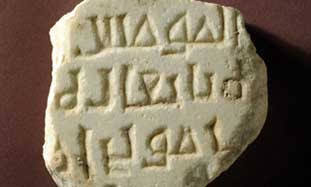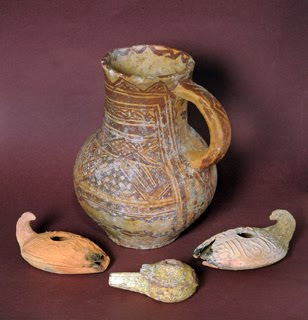Medieval History
 A 10th century Arabic inscription was discovered in excavations in a private house in the Jewish Quarter of Jerusalem, according to a statement released Wednesday by the Israel Antiques Authority.
A 10th century Arabic inscription was discovered in excavations in a private house in the Jewish Quarter of Jerusalem, according to a statement released Wednesday by the Israel Antiques Authority.
The house is located north of the Crusader period Church of St Mary of the Germans. Part of the church?s foundations and the remains of a building, which dates to the time when the Ayyubids ruled the city after capturing it from the Crusaders (13th century CE), were uncovered in the excavation.
The inscription was found on a fragment of a marble plaque (20 x 20 cm) and consists of three engraved lines of square Arabic script that is characteristic of the first centuries of the Islamic period. Professor Moshe Sharon of the Hebrew University of Jerusalem deciphered the writing based on two similar inscriptions that were previously discovered in the country.
According to Professor Sharon, ?The inscription that was found now, which dates to the year 910 CE, and other such inscriptions, commemorates the granting of an estate by the Abbasid caliph to one of his loyal followers in Jerusalem. We know from this type of official inscription that the caliph used to give land to his followers who were, for the most part, retired army veterans, and even exempted them from paying taxes for the receipt of the property?.
Annette Nagar, the excavation director on behalf of the Israel Antiquities Authority, who discovered the inscription, says, ?The reign of the Abbasid caliph Al-Muqtadir (also known as ?Emir of the Faithful?; 908-932 CE) was characterized by repeated wars for control over Israel with the Fatimids, who ruled Egypt,. The caliph probably granted estates as part of his effort to strengthen his hold over the territories within his control, including Jerusalem, just as other rulers did in different periods?.
 In addition to the inscription, numerous ceramic vessels, glass vessels and coins that range in date from the Second Temple period to the Middle Ages were discovered in the excavation. Noteworthy among the pottery are the oil lamps decorated with Arabic inscriptions that were found in the foundations of the Ayyubid structure and on its floor.
In addition to the inscription, numerous ceramic vessels, glass vessels and coins that range in date from the Second Temple period to the Middle Ages were discovered in the excavation. Noteworthy among the pottery are the oil lamps decorated with Arabic inscriptions that were found in the foundations of the Ayyubid structure and on its floor.
The house?s owner planned a renovation and ? as required by law ? brought archaeologists to carry out a salvage dig meant to prevent harm to valuable antiquities.
The finding will help scholars better understand 10th-century Jerusalem, populated by Muslims, Christians and Jews, and the methods used by Muslim rulers to solidify their control.
- Ancient Seal Discovered In Jerusalem
In archaeological work in the 2,000 year-old drainage channel between the City of David and the Jerusalem Archaeological Garden, remains were discovered of the building closest to the First Temple exposed so far in archaeological excavations. The...
- 1,600 Year-old Bathhouse Discovered In Israel
Archaeologists in Israel have uncovered a 1,600 year-old bathhouse apparently used by the owners of a wealthy estate or an inn on an ancient road. Remains of an ancient bathhouse dating to the Byzantine period were exposed during work being conducted...
- 1500-year-old Building Discovered At Acre
Archaeologists in Israel have discovered a 1500 year old building in the historic city of Acre (also known as Akko). The Israel Antiquities Authority announced the find earlier this month, which they believe may have been a Byzantine church. According...
- Byzantine Church And Mosaic Floor Uncovered In Israel
Archaeologists working for the Israel Antiquities Authority have announced they have discovered the remains of a 1500-year-old Byzantine church that was believed to have been the final resting place of an ancient Jewish prophet. A large and beautiful...
- Crusader Marble Hoard Discovered
In an excavation that was recently conducted c. 100 meters north of the Old City wall of Akko, a unique find was discovered from the Crusader period (the thirteenth century CE) ? a hoard of 350 marble items that were collected from buildings that had...
Medieval History
10th century Arabic inscription found in Jerusalem

The house is located north of the Crusader period Church of St Mary of the Germans. Part of the church?s foundations and the remains of a building, which dates to the time when the Ayyubids ruled the city after capturing it from the Crusaders (13th century CE), were uncovered in the excavation.
The inscription was found on a fragment of a marble plaque (20 x 20 cm) and consists of three engraved lines of square Arabic script that is characteristic of the first centuries of the Islamic period. Professor Moshe Sharon of the Hebrew University of Jerusalem deciphered the writing based on two similar inscriptions that were previously discovered in the country.
According to Professor Sharon, ?The inscription that was found now, which dates to the year 910 CE, and other such inscriptions, commemorates the granting of an estate by the Abbasid caliph to one of his loyal followers in Jerusalem. We know from this type of official inscription that the caliph used to give land to his followers who were, for the most part, retired army veterans, and even exempted them from paying taxes for the receipt of the property?.
Annette Nagar, the excavation director on behalf of the Israel Antiquities Authority, who discovered the inscription, says, ?The reign of the Abbasid caliph Al-Muqtadir (also known as ?Emir of the Faithful?; 908-932 CE) was characterized by repeated wars for control over Israel with the Fatimids, who ruled Egypt,. The caliph probably granted estates as part of his effort to strengthen his hold over the territories within his control, including Jerusalem, just as other rulers did in different periods?.

The house?s owner planned a renovation and ? as required by law ? brought archaeologists to carry out a salvage dig meant to prevent harm to valuable antiquities.
The finding will help scholars better understand 10th-century Jerusalem, populated by Muslims, Christians and Jews, and the methods used by Muslim rulers to solidify their control.
- Ancient Seal Discovered In Jerusalem
In archaeological work in the 2,000 year-old drainage channel between the City of David and the Jerusalem Archaeological Garden, remains were discovered of the building closest to the First Temple exposed so far in archaeological excavations. The...
- 1,600 Year-old Bathhouse Discovered In Israel
Archaeologists in Israel have uncovered a 1,600 year-old bathhouse apparently used by the owners of a wealthy estate or an inn on an ancient road. Remains of an ancient bathhouse dating to the Byzantine period were exposed during work being conducted...
- 1500-year-old Building Discovered At Acre
Archaeologists in Israel have discovered a 1500 year old building in the historic city of Acre (also known as Akko). The Israel Antiquities Authority announced the find earlier this month, which they believe may have been a Byzantine church. According...
- Byzantine Church And Mosaic Floor Uncovered In Israel
Archaeologists working for the Israel Antiquities Authority have announced they have discovered the remains of a 1500-year-old Byzantine church that was believed to have been the final resting place of an ancient Jewish prophet. A large and beautiful...
- Crusader Marble Hoard Discovered
In an excavation that was recently conducted c. 100 meters north of the Old City wall of Akko, a unique find was discovered from the Crusader period (the thirteenth century CE) ? a hoard of 350 marble items that were collected from buildings that had...
